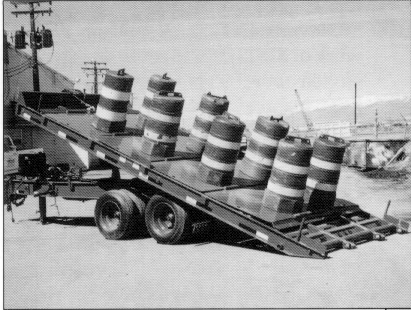Portable Crash Cushion Trailer Now Easier to Handle
The second generation prototype of the portable crash cushion trailer is now ready for field testing. Initially developed as part of the Strategic Highway Research Program (SHRP), the device allows work crews to quickly deploy sand-filled barrels to close a traffic lane or shield construction equipment in a work zone. The barrels can be used at work sites to protect highway workers and cushion the impact of a crash.
Setting up crash barrels is an arduous and time-consuming job that exposes workers to considerable danger. By making the process easier and faster, the risk to workers is lessened.
The portable crash cushion trailer is a tilt-bed trailer equipped with a pallet of hinged steel plates. Sand-filled barrels are secured to the pallet, and a winch is provided to assist in installation and removal of the barrels. Rollers on the trailer bed allow the pallet to easily slide on and off the trailer. The second generation prototype overcomes two problems that had been found in field testing. The first was that the sand barrels could be loaded and unloaded from one direction only. In some situations, this made setting up the portable crash cushion difficult. The other problem was that the 12-m-long (40-ft) trailer was too big for narrow roads and for many work zones.
The new version addresses both problems. The trailer can now be loaded with either the heavy barrels or the light barrels at the front, in preparation for unloading at a particular site.

The revised prototype is also half as long as the original design, with only four hinged segments to the pallet. The improved design's greater maneuverability makes it safer for crews to load and unload. Deploying a crash cushion in two sections has another advantage. If one half of the crash cushion is struck by a vehicle and destroyed, the highway agency can replace just the damaged section rather than the complete array.
The improved trailer, built by Williamsen Manufacturing Inc., is now headed for testing and evaluation in five states. Alabama, California, Minnesota, and New York will evaluate the second-generation prototype in its basic form. Iowa, which is currently testing the original trailer, will evaluate a slightly modified model designed to carry heavier barrels and to be deployed behind the original trailer.
For more information, contact Harry Taylor at FHWA, 202-3662175 (fax: 202-366-2249; email: htaylor@intergate.dot.gov)